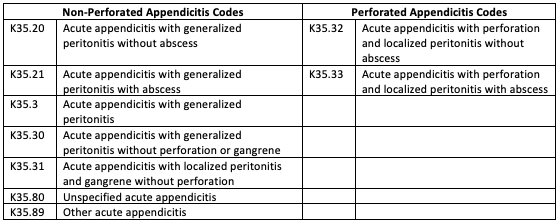Obesity
Obesity 1
392 - Pediatric Overweight or Obesity Not Associated with Perforation in Acute Appendicitis: A Retrospective Study
Publication Number: 392.145

Rachael M. Cannon, MD (she/her/hers)
Pediatric Resident
HCA Florida Palms West Hospital
Loxahatchee, Florida, United States
Presenting Author(s)
Background:
Acute appendicitis (AA) is one of the most common surgical diagnoses. Despite urgent surgery, the rate of appendiceal perforation remains consistent [1]. Previous studies showed a decreased rate of negative appendectomies with an increased use of diagnostic imaging, but there was no significant change in the rate of appendiceal perforation [1]. Furthermore, perforated appendicitis may result in increased morbidity, increased hospital length of stay, and associated increased hospital costs [2,3].
Objective:
To determine if pediatric patients with overweight or obesity were more likely to experience appendiceal perforation than normal weight patients.
Design/Methods:
This was a retrospective cohort study of pediatric patients from any HCA East, North, or West Florida Division facility diagnosed with one of nine ICD-10 codes for AA from January 1, 2014 to December 31, 2019. The age, sex, race, body mass index (BMI), and full complement of diagnoses was also queried. Logistic regression analysis was performed to give an adjusted odds ratio between BMI categories, age, sex, and perforated versus non-perforated appendicitis.
Results:
Children with overweight or obesity were more likely to perforate, with an odds ratio of 1.268, but the p-value of 0.1475 was not statistically significant. Females were more likely to perforate than males, with a p-value approaching significance at 0.0511 and an odds ratio of 1.377. Older children were less likely to perforate than younger children, with a p-value of 0.0011 and an odds ratio of 0.934.
Conclusion(s):
Children with overweight or obesity were not more likely to perforate than normal weight children. However, the results could differ if children with obesity and children with overweight were distinct cohorts. Younger children perforated more frequently than older children, possibly due to their decreased ability to convey symptoms. At a p-value that approached significance, females perforated more often than males. Repeat studies are warranted for weight, age, and sex to determine the significance of their effect on the risk of appendiceal perforation in AA.
References
[1] Tarulli M, Rezende-Neto J, Vlachou PA. Focused CT for the evaluation of suspected appendicitis. Abdom Radiol. 2019;44(6):2081-2088. doi:10.1007/s00261-019-01942-3.
[2] Wagner M, Tubre DJ Asensio JA. Evolution and current trends in the management of acute appendicitis. Surg Clin N Am. 2018;98:1005-1023. doi: 10.1016/j.suc.2018.05.006.
[3] Kliegman R, et al. Chapter 370: Acute Appendicitis. Nelson Textbook of Pediatrics. 21st ed. Philadelphia, PA: Elsevier, 2020: 2051, 2054.


